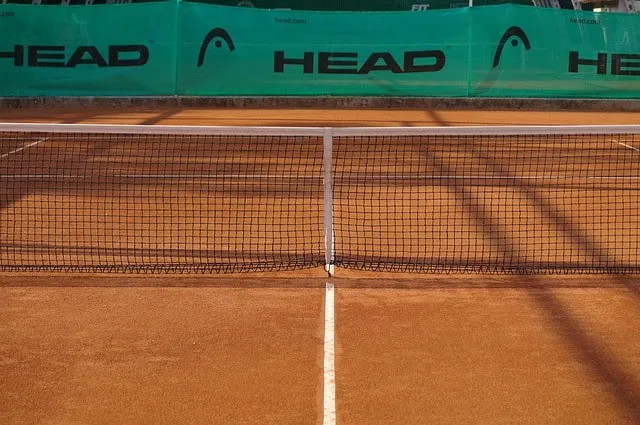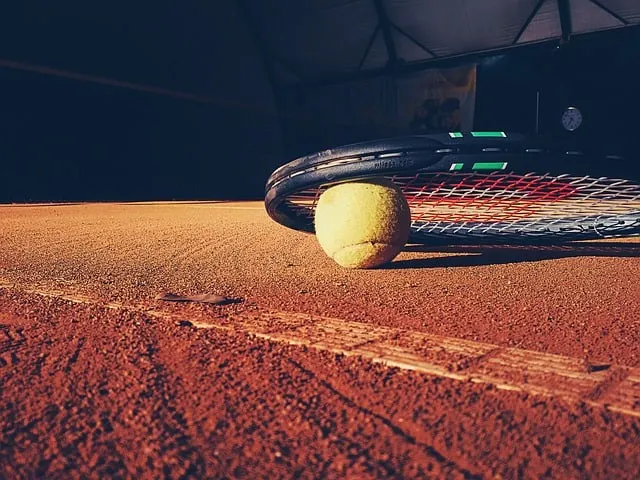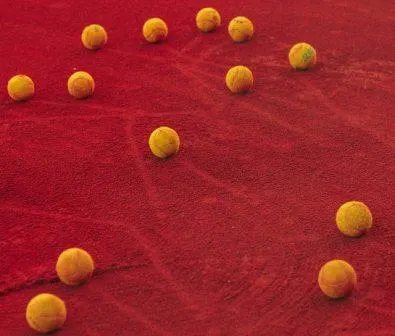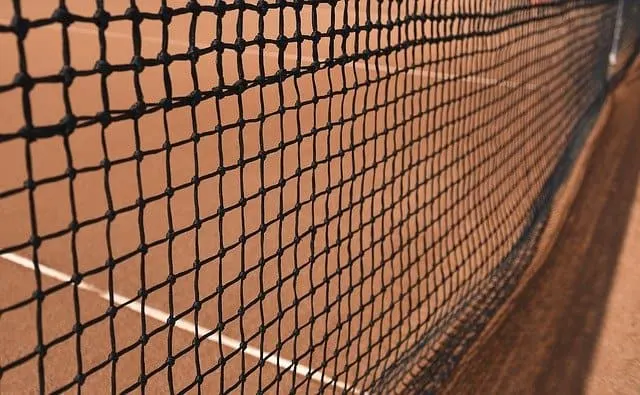
Along with everything else in 2020, tennis has had to adapt in the face of COVID-19. The Australian Open went ahead as normal, Wimbledon was cancelled completely, the US Open went ahead albeit without any spectators, and the French Open has been put back to the end of September.
Consequently the clay court season, normally between April and June each year, has been in September as professional players prepare themselves for the final grand slam of the year at Roland Garros.
Clay court tennis is very different from the other surfaces. It’s slower, rallies are longer and the ball kicks up a lot more.
In this article, let’s take a look at how to make a clay tennis court, including setting up solid foundations and drainage underneath, to installing the right surface and ensuring it’s properly maintained.
What material makes up a clay tennis court?
Clay courts consist of a combination of crushed brick, shale, stone and other aggregates. Although you can get green clay, the most common is red, which is what you find at the French Open and at other tournaments on the ATP and WTA tour. They are generally more common in Spain, France and throughout continental Europe, where as other surface types are more prevalent in the UK and USA.
Why build a clay tennis court?
There are a number of reasons why clay is a great surface for tennis. Typically it’s cheaper to install if you’re using a Har-Tru court, costing about 5-10% less than a hard court, and you only need about 10 minutes or so a day to maintain it. Playing on clay is also great for your body, as you’re less likely to pick up injuries than on grass or hard courts. You’ll also become fitter due the longer rallies, so your overall stamina and endurance will improve. Finally, clay courts dry quicker than other surfaces so after a spot of rain, you can be playing again after just 15-20 minutes.

How to make a clay tennis court
Here is the process for making a clay tennis court. Aside from the material used, it’s very similar to building other types of tennis courts. You want to pick an area which is not too close to trees as the roots could cause problems under the surface, and make sure the court faces north or south, so the sun won’t disturb you as much when you play.
Measuring and preparation
Firstly you need to measure the total area you need. For a recreational court, the minimum recommended size is 114’ x 60’, but as the ball bounces higher on clay, you’d be better off conforming to the minimum international specifications which is 120’ x 60’. This will give you a bit more space at the back of the court to return any heavy topspin shots which will kick up off the clay.
Once everything is measured, you should bore to a level of at least 4’. This will reveal the quality of the sub base and whether there are any roots or organic material underneath. You should also check if the water table is too high. Only after this can you start constructing your tennis court. Everything starts with a solid foundation!
Building the foundation
Once you’ve measured and checked the area carefully, it’s time to start building. Firstly you need to ensure the sub base is compacted as much as possible, with a slight drop of 1” for every 20-28” as this helps with drainage. Then you add a layer of base stone which should be at least 2.5” thick up to around 6”. This helps with drainage and prevents the court from sinking or moving over time. You should compact this base stone once it’s all in place.
Above this, there is a layer of stone screening which helps to retain moisture and keep the court slightly moist which is ideal for clay court tennis. It should have a consistent depth of no less than 3/4”, and it should be compacted afterwards. If you want any underground irrigation for your tennis court, you should install this before the stone screening.
Then you can add the top layer of clay, which should be watered, rolled and compacted.
It should be noted that this 3 layer option is common for Har-Tru courts in the US. At Roland Garros, there are 5 layers!

How do they paint the lines on a clay tennis court?
In order to mark out the lines properly, here is the process you should follow in order to ensure the lines are correct for your clay tennis court:
- Measure everything out correctly, including the service boxes and tramlines.
- Use nails to mark down the spots where the lines will go down.
- Use some chalk lines as a guide so when you apply the tape it will be in a straight line.
- Apply the line tape, ensuring you fasten the corners down with nails where there is some overlap.
- Insert nails into the line tape and into the ground, but leave them sticking out slightly.
- Roll down the lines to make everything even, including the nails so they aren’t sticking out of the ground.
- Cut off any excess tape so every line and corner is smooth.
Source: http://courtauthority.10-s.com/how-to-lay-new-lines-on-a-clay-tennis-court.html
How much does it all cost?
It depends on the type of clay you’re using, and where you’re based, but on average a clay tennis court will probably cost around $45,000. You also have maintenance costs on top of that which can run into a couple of thousand dollars a year to roll the clay, water it regularly etc.
How to maintain a clay tennis court
In order to properly maintain a clay tennis court there are various daily, weekly and monthly tasks you need to do. This will ensure you get more longevity from the playing surface before you have to replace the clay altogether. You should be brush and water the courts every day.
How to roll a clay tennis court
In order to keep the playing surface in great shape, clay tennis courts need be rolled with a special rolling machine. For moderate use, if the clay court has a sub-surface irrigation system, you’ll only need to roll the court once per month. For clay courts which have to be watered above ground, you’ll really need to roll 1-3 times a week.
You have to also roll when the clay has the right amount of moisture. If the court is too dry then rolling won’t have much of an effect. However, if you try when it is too wet, you can easily damage the surface. When the clay is slightly moist to touch, then it’s the ideal time to start rolling the surface.
You should roll in a straight line going forwards and then back. Avoid sharp turns and take special care when going over the lines.
How to brush a clay tennis court
You should brush clay court should before or after every match. There are two main types of sweepers; one for doing the main clay surface, and a line sweeper to go over the lines. For the main sweep, make sure you do it everywhere including the playing area, the back of the court and close to the net. For line sweeping, press lightly and don’t go beyond the lines as that can leave a mark and confuse tennis players during a game.
It’s also a good idea to brush a clay tennis court before rolling as that can make it clearer which parts of the surface have been rolled or not.
How do you resurface a clay tennis court?
You should resurface a clay tennis court every few years, but it depends how often the court is used, and how well it has been maintained. A court with a sub surface irrigation system will last longer than one which is watered with a sprinkler system.
Cleaning and removing old clay
For resurfacing, you need to clean the court thoroughly first, ensuring all mold and algae has been removed. Then you should remove lines from the surface, pulling up the tape and all the nails holding it in place. After this, it’s best to lightly scrape and remove the dead material from the playing surface, collecting the excess clay in piles and removing it from the court.
After this initial phase, you want to scarify the tennis court to rough up and loosen the clay so you can redistribute some of it around the playing surface.

Laying down the new clay
Now you’re ready to add the new clay, but you should use a laser grade to distribute the clay evenly from the low end to the high end ensuring there is a slight slope to help with drainage. Once all the new clay has been added, you should level everything again. You can do this with a ladder or anything with a long straight edge. Then brush over the whole surface, water sufficiently, and roll over the surface.
Once all this has been completed you should add another layer of clay just in case there are any slight issues or imperfections with the surface. You should level, brush, water and roll again.
Watering and rolling should be done another 2-3 times before marking out the court, and installing the lines, net posts and net. You might want to apply an algaecide to the surface to prevent any mold or algae building up over time.
Once everything is complete, you should brush, water and roll more often during the first week to keep the surface firm.
Frequently Asked Questions
Why do you water clay tennis courts?
An irrigation system is essential for keeping the clay court surface stable and firm. Watering the court also helps keep the lines in place, resulting in less bad bounces during a game and it minimizes the risk of the clay eroding. From a financial point of view, watering the courts regularly keeps the surface in better condition for longer, so you won’t have to resurface the clay as often. It’s best to water after brushing, and only for short periods so the clay can absorb the moisture.
What is under a clay tennis court?
There are number of layers that make up a clay tennis court, but it also depends what type of clay court you want to build. At Roland Garros, there are 5 layers of different material. On top there is a thin layer of crushed red brick, which gives the courts their iconic colour. However, going deeper underneath there is a layer of crushed limestone, a layer of coal residue, some crushed gravel, and some stones at the bottom, just above the soil.
For HAR-TRU tennis courts, found in the US (which look and play very similar to clay courts in Europe) there are only 3 layers; a bottom layer of stones for drainage, a thinner layer of smaller stones for screenings and a one inch layer of HAR-TRU on top.
How thick is the clay on a tennis court?
For a HAR-TRU court, the top layer is around 1” thick. At Roland Garros, the signature red clay is a lot thinner, at just 1/12”.
What are the lines made of on a clay tennis court?
Unlike hard and grass courts, lines aren’t painted on a clay court. You should use white fabric tape or plastic which nails down into the clay. The nail head must not be smooth as it could present a slipping hazard. The exception is at Roland Garros where they use a special paint which is applied quite thickly into the surface.
